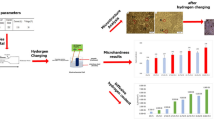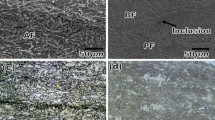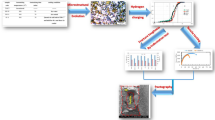Abstract
In this study, we used thermo–mechanical control process (TMCP) technique to investigate the effect of arisen dislocation density and texture components on hydrogen induced cracking susceptibility in as-received API X60 pipeline steel. Dislocations and texture components appeared during cold rolling and annealing treatments. X-ray diffraction and electron backscatter diffraction measurements were used to study these phenomena. We observed that the cold rolling and annealing treatments produced higher dislocation density in deformed and recovered regions. The increase of dislocation density also caused the increased hydrogen trap density. Macro-texture studies by x-ray method indicates that initial weak texture of as-received X60 steel was changed from ζ-fiber to γ-fiber and θ-fiber in 90% cold rolled and annealed specimen. Therefore, the number of grains with {100}ND orientation which had a harmful effect on hydrogen induced cracking susceptibility increased. The {100} dominant texture and high density of hydrogen traps mitigated against any possible benefits of the other microstructural parameters such as coincidence site lattice boundaries and grain size. As a result, we could not consider this process as a suitable method to increase hydrogen induced cracking resistance in pipeline steel.










Similar content being viewed by others
References
M.A. Mohtadi-Bonab, J.A. Szpunar, R. Basu, and M. Eskandari: The mechanism of failure by hydrogen induced cracking in an acidic environment for API 5L X70 pipeline steel. Int. J. Hydrogen Energy 40, 1096 (2015).
J. Moon, C. Park, and S.J. Kim: Influence of Ti addition on the hydrogen induced cracking of API 5L X70 hot-rolled pipeline steel in acid sour media. Met. Mater. Int. 18, 613 (2012).
J. Moon, S.J. Kim, and C. Lee: Role of Ca treatment in hydrogen induced cracking of hot rolled API pipeline steel in acid sour media. Met. Mater. Int. 18, 45 (2013).
T. Depover, D. Pérez Escobar, E. Wallaert, Z. Zermout, and K. Verbeken: Effect of hydrogen charging on the mechanical properties of advanced high strength steels. Int. J. Hydrogen Energy 39, 4647 (2014).
V. Schwinn and A. Thieme: TMCP steel plates for sour service linepipe application. In International Seminar of Modern Steels for Gas and Transmission Pipelines, Problems and Prospects, Moscow, 2006.
H. Tamehiro, T. Takeda, S. Matsuda, K. Yamamoto, and H. Okomura: Effect of accelerated cooling after controlled rolling on the hydrogen induced cracking resistance of pipeline steel. Trans Iron Steel Inst. Jpn. 25, 982 (1985).
C. Collura, T. Staudt, J. Bauer, V. Schewinn, D. Clipet, and E. Amoris: Development of X70 and heavy wall X65 plates for sour service pipeline application. In Offshore Technology Conference, Brazil, 2013.
M.A. Mohtadi-Bonab, J.A. Szpunar, and S.S. Razavi-Tousi: Hydrogen induced cracking susceptibility in different layers of a hot rolled X70 pipeline steel. Int. J. Hydrogen Energy 38, 13831 (2013).
V. Venegas, F. Caleyo, T. Baudin, J.H. Espina-Hernandez, and J.M. Hallen: On the role of crystallographic texture in mitigating hydrogen-induced cracking in pipeline steels. Corros. Sci. 53, 4204 (2011).
V. Venegas, F. Caleyo, J.M. Hallen, T. Baudin, and R. Penelle: Role of crystallographic texture in hydrogen-induced cracking of low carbon steels for sour service piping. Metall. Mater. Trans. A 38, 1022 (2007).
V. Venegas, F. Caleyo, T. Baudin, J.M. Hallen, and R. Penelle: Role of microtexture in the interaction and coalescence of hydrogen-induced cracks. Corros. Sci. 51, 1140 (2009).
V. Venegas, F. Caleyo, O. Herrera, J. Hernández-Sánchez, and J.M. Hallen: Crystallographic texture helps reduce hydrogen induced cracking in pipeline steels. Int. J. Electrochem. Sci. 9, 418 (2014).
V. Venegas, F. Caleyo, J.M. Hallen, and T. Baudin: On the influence of crystallographic texture on HIC in low carbon steel. In International Conference of Crack Paths, Parma, Italy, 2006.
M.A. Mohtadi-Bonab, M. Eskandari, and J.A. Szpunar: Texture, local misorientation, grain boundary and recrystallization fraction in pipeline steels related to hydrogen induced cracking. Mater. Sci. Eng., A 620, 97 (2015).
A.J. Haq, K. Muzaka, D.P. Dunne, A. Calka, and E.V. Pereloma: Effect of microstructure and composition on hydrogen permeation in X70 pipeline steels. Int. J. Hydrogen Energy 38, 2544 (2013).
D. Hejazi, A.J. Haq, N. Yazdipour, D.P. Dunne, A. Calka, F. Barbaro, and E.V. Pereloma: Effect of manganese content and microstructure on the susceptibility of X70 pipeline steel to hydrogen cracking. Mater. Sci. Eng., A 551, 40 (2012).
N. Yazdipour, A.J. Haq, K. Muzaka, and E.V. Pereloma: 2D modelling of the effect of grain size on hydrogen diffusion in X70 steel. Comput. Mater. Sci. 56, 49 (2012).
M.A. Mohtadi-Bonab, J.A. Szpunar, L. Collins, and R. Stankievech: Evaluation of hydrogen induced cracking behavior of API X70 pipeline steel at different heat treatments. Int. J. Hydrogen Energy 39, 6076 (2014).
W.Y. Choo and J. Young Lee: Effect of cold working on the hydrogen trapping phenomena in pure iron. Metall. Trans. A 14, 1299 (1983).
M.A. Mohtadi-Bonab, J.A. Szpunar, and S.S. Razavi-Tousi: A comparative study of hydrogen induced cracking behavior in API 5L X60 and X70 pipeline steels. Eng. Failure Anal. 33, 163 (2013).
F.J. Humphreys and M. Hatherly: Recrystallization and Related Annealing Phenomena, 2nd ed. (Elsevier Science Ltd., Oxford, UK, 2004).
O. Engler and V. Randle: Introduction to Texture Analysis-Macrotexture, Microtexture, and Orienatation Mapping, 2nd ed. (Taylor & Francis Group, New York, 2010); p. 490.
R. Jamaati, M.R. Toroghinejad, M.A. Mohtadi-Bonab, H. Edris, J.A. Szpunar, and M.R. Salmani: Texture development of ARB-processed steel-based nanocomposite. J. Mater. Eng. Perform. 23, 4436 (2014).
D. Raabe: Overview on basic types of hot rolling textures of steels. Steel Res. 74, 327 (2003).
D. Raabe and K. Lucke: Texture and microstructure of hot rolled steel. Scr. Metall. Mater. 26, 1221 (1992).
L. Storojeva, D. Ponge, R. Kaspar, and D. Raabe: Development of microstructure and texture of medium carbon steel during heavy warm deformation. Acta Mater. 52, 2209 (2004).
D. Raabe: Texture and microstructure evolution during cold rolling of a strip cast and of a hot rolled austenitic stainless steel. Acta Mater. 45, 1137 (1997).
M. Eskandari, M.A. Mohtadi-Bonab, and J.A. Szpunar: Evolution of the microstructure and texture of X70 pipeline steel during cold-rolling and annealing treatment. Mater. Des. 90, 618 (2016).
ACKNOWLEDGMENT
We would like to thank Natural Sciences and Engineering Research Council of Canada for the financial support of this project.
Author information
Authors and Affiliations
Corresponding author
Rights and permissions
About this article
Cite this article
Mohtadi-Bonab, M.A., Eskandari, M. & Szpunar, J.A. Effect of arisen dislocation density and texture components during cold rolling and annealing treatments on hydrogen induced cracking susceptibility in pipeline steel. Journal of Materials Research 31, 3390–3400 (2016). https://doi.org/10.1557/jmr.2016.357
Received:
Accepted:
Published:
Issue Date:
DOI: https://doi.org/10.1557/jmr.2016.357




